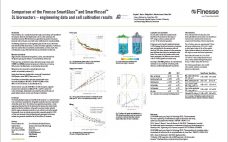Antibody-mediated haemolysis is a hard-to-predict phenomenon with potentially severe consequences. It is mediated by naturally-occurring anti-A and anti-B immunoglobulin isoagglutinins, which are present in plasma, blood, and several derived products, including IVIG produced by plasma fractionation. Prometic Bioseparations have developed an affinity chromatography resin for the removal of isoagglutinins from plasma and plasma derived products, such as IVIG. The resins, IsoClear A and IsoClear B, can clear isoagglutinins from a titre of 1/32 down to negative agglutination using a load…
Poster Hall
Expansion, Recovery and Characterization of hMSCs on Dissolvable Microcarriers for Bioprocess Applications
Human mesenchymal stem cells (hMSCs) are currently the most common adult stem cell type used for cell therapy applications due to their regenerative properties and ability to differentiate into multiple cell lineages (adipocyte, chondro¬cyte, and osteocyte). Traditionally, hMSCs have been cultured on two-dimensional cell culture platforms using serum-containing medium. Although these platforms can be used successfully for small-scale expansion of hMSCs, other platforms will be required to generate the quantity of cells required to support the increasing number of clinical…
Comparison of the Finesse SmartGlass™ and SmartVessel™ 3L Bioreactors: Engineering Data and Cell Cultivation Results
Finesse Solutions Inc. recently introduced the single-use benchtop scale SmartVessel 3L bioreactor, which was developed based on its re-usable counterpart, the SmartGlass bioreactor. With identical main geometrical parameters, the plastic bioreactor mimics the glass vessel with minor modifications for manufacturability. The following study focuses on the engineering data of both vessels, which have been determined with special focus on animal cell culture applications. Furthermore, data from material tests on leachables and extractables as well as results from cell cultivations using…
An Introduction to the FUTURA pico for Mini-bioreactors
Small bioreactors are gaining share in process development laboratories. It is vital that these bioreactors are realistic scale down models of larger systems and it is equally important that online sensors for measuring live biomass can also be used in these vessels. ABER, known and trusted for its sensors that measure live cell concentrations using capacitance technology and adopted in the world’s leading bio pharmaceutical companies from R&D through to cGMP processes brings you the new FUTURA PICO. Our Conventional…
Resin Selection to Optimize the Flexural Strength of Bioprocess Film
Abstract Single-use bioprocess technology offers several advantages for manufacturing biopharmaceuticals, such as increased transportability of fluids throughout the bioprocess workflow and a greater diversity of systems to support specific unit operations, e.g., rocking bioreactors. However, due to the flexible nature of the plastic materials used to construct the single-use containers, the flexural properties of the bioprocess film are critical for performance in such applications. This document focuses on how the resin selection and architecture of a bioprocess film can be…
A Scalable Immobilized Metal Affinity Chromatography Resin for Process Purification
Downstream process purification of proteins requires a resin with optimized bead size for ideal pressure/flow properties and decent dynamic binding capacity (DBC) that provides production efficiencies and good process economics. Our newly developed metal chelate affinity resin — Nuvia™ IMAC — provides the mechanical strength, pore structures, ligand density, and particle size distribution required for an operation run at 300 cm/hr with a DBC of > 40 mg/ml at < 2 bar column backpressure. Protein purification can efficiently be scaled…
Reducing the Complexity of Custom Single-Use Assemblies
Single-use technology (SUT) has been adopted on a global scale since its introduction 20 years ago. Its benefits are well-recognized, and it is a key enabling technology in today’s biopharm world. Thousands of single-use products are now on the market and entire processes are being run in single-use systems. Historically, end users have been encouraged to produce ‘customized’ single-use solutions for each individual application. While this can give the user exactly what they want, it can be at the expense…
New Agarose-Based Protein A Resins Designed for Cost Effective Purification of MAbs
It is well recognized that the cost of Protein A resins is substantial. If a product makes it to marketing approval and manufacturing the high cost is amortized over a large number of purification cycles then the contribution to cost of goods is acceptable. However, a high percentage of clinical projects will fail and the Protein A resin will only be used for a small number of cycles. One way to address this issue is to use a less expensive…
Adopting a Fully Single-use Process to Improve Speed to Clinic: A Leachables Case Study
The implementation of single-use technologies for pharmaceutical product development continues to gain momentum; this trend is due to the advantages of increased flexibility, speed of implementation and lower capital investment. In particular, they are seen as a means to accelerate the production of material for clinical trials. However, a primary concern regarding the use of such technologies is the impact and level of leachables in the final drug substance. Typically this concern is addressed through a risk assessment utilizing extractable…
Efficient Virus Clearance Across the MilliporeSigma Downstream Purification Portfolio
The downstream purification process of any biologic has several objectives: purity, yield, and safety for humans or animals. A critical component of safety assurance is reducing virus to levels that meet stringent regulatory requirements. Virus reduction can be achieved through multiple complementary approaches and most processes rely on a combination of technologies that are designed primarily to achieve purification targets, but may also offer opportunities for virus reduction. The purpose of this project was to establish capabilities for producing a…










